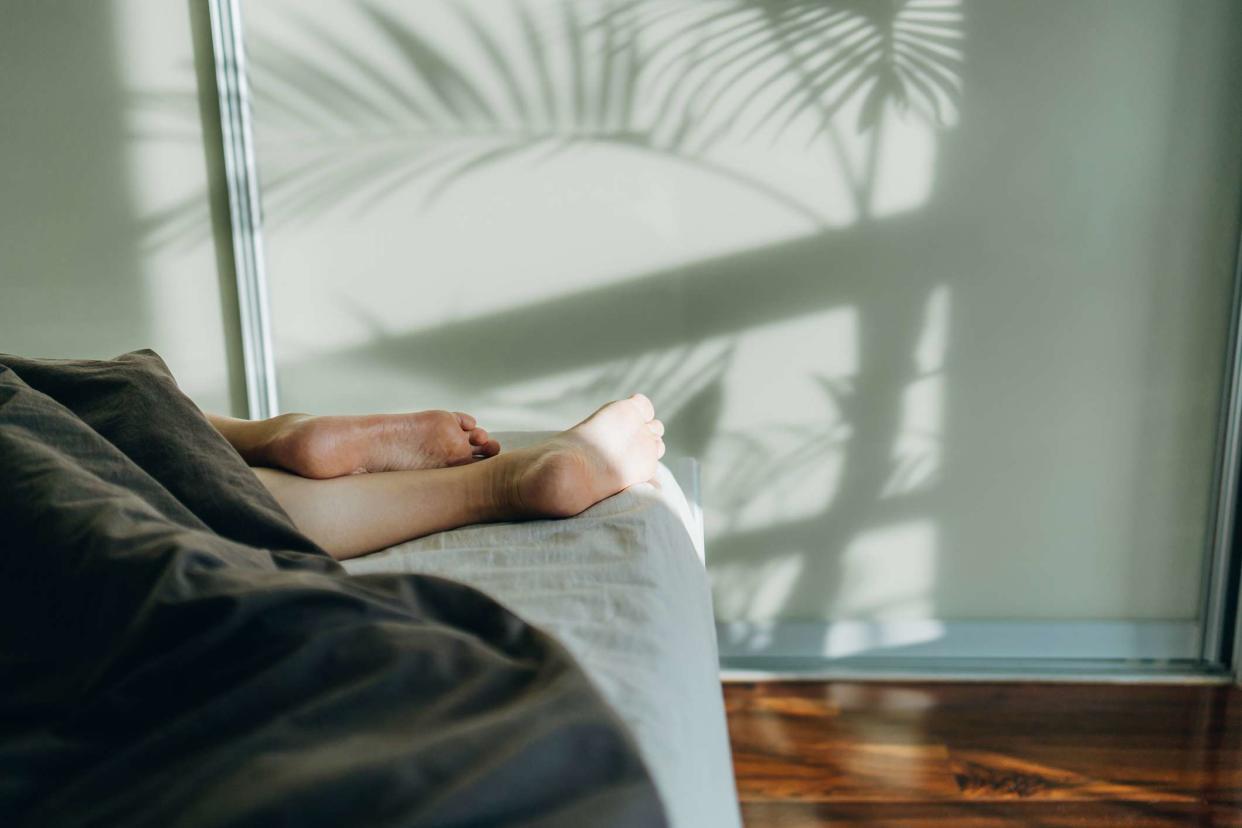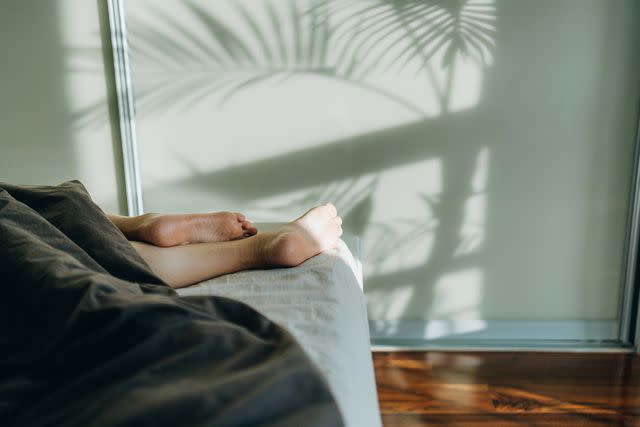What Is Periodic Limb Movement Disorder (PLMD)?

d3sign / Getty Images
Medically reviewed by Jordana Haber Hazan, MD
Periodic limb movements of sleep (PLMS) and periodic limb movement disorder (PLMD) are conditions that cause recurrent involuntary movements during sleep. Sometimes PLMS can be part of other sleep disorders, such as narcolepsy or restless legs syndrome (RLS). Rarely, PLMD can occur without another sleep disorder.
Excessive limb movements during sleep can cause daytime sleepiness. The diagnosis can involve a detailed medical history, as well as diagnostic testing with sleep studies. This article describes PLMS and PLMD, including the symptoms, causes, and treatments.

d3sign / Getty Images
Types of Periodic Limb Movement
PLMS describes movements that occur during non-rapid eye movement (NREM or non-REM) sleep. This is the non-dreaming phase of sleep.
When periodic limb movements are a recurrent problem during sleep, the condition would be defined as PLMD.
Learn More:The 4 Stages of Sleep
Periodic Limb Movement Symptoms
The main symptoms of PLMD are fatigue and daytime sleepiness. Some people may also experience morning headaches. These symptoms occur because the limb movements that occur during sleep can prevent your sleep from being as restful and efficient as it normally would be.
The NREM sleep stages are stages of sleep when you aren’t dreaming. It’s normal to toss and turn during NREM sleep. The movements that are defined as periodic limb movements of sleep include jerking, twitches of the limbs, and muscle cramping—which are different from the typical tossing and turning of the NREM sleep stages.
Most people who have PLMS and PLMD aren't aware of the movements and are not bothered by them because they occur during sleep. If you have a bed partner, they might notice your limb movements while you are sleeping—especially if your bed partner is a light sleeper.
Associated Symptoms
It's common for PLMS to be part of another sleep disorder. When someone has periodic limb movements during sleep as part of another sleep disorder, the symptoms of the underlying sleep disorder can be more noticeable than the periodic limb movements that happen during sleep.
Symptoms can include:
RLS: A feeling of restlessness and an urge to move the legs when trying to sleep
Narcolepsy type 1 or type 2: Falling asleep during the day, sometimes suddenly
Narcolepsy type 1: Cataplexy (sudden loss of muscle tone during the day)
Obstructive sleep apnea: Snoring and daytime fatigue
Causes
Anyone can occasionally experience periodic limb movements during sleep, even without any underlying sleep disorder. Some people might have limb movements during sleep due to short-term sleep deprivation, medications, or a night of insomnia.
These movements can also be recurrent as part of certain sleep disorders. Rarely, the movements are a chronic problem without a risk factor or another sleep disorder.
Conditions associated with periodic limb movements during sleep include:
RLS
Narcolepsy
Snoring
Chronic insomnia
Mood disorders
Behavioral problems in children
Chronic heart disease
Medications that can increase the risk of limb movements during sleep include antipsychotics, anti-seizure medications, or selective serotonin reuptake inhibitors (SSRI) and serotonin and norepinephrine reuptake inhibitors (SNRI) antidepressants.
Diagnosis
PLMS is diagnosed based on a medical history and testing. You would not notice that you are experiencing limb movements during sleep, but if you have a partner who shares a bed with you, they might notice. Often, sleep disorders are considered when someone has symptoms of excessive daytime fatigue.
During an evaluation for a possible sleep disorder, you might be given questionnaires, such as the Pittsburgh Sleep Quality Index (PSQI), which includes questions about the quality of sleep and time spent asleep. A polysomnogram (sleep study) includes an assessment of movements during sleep and can detect jerks and twitches that occur during NREM sleep.
A polysomnogram is a noninvasive, multifaceted sleep study that uses:
Electroencephalogram: To assess the time spent in each sleep stage
Noninvasive electrodes: To evaluate muscle movements during sleep
Pulse oximetry: To measure blood oxygen saturation
Differential Diagnosis
A key feature of periodic limb movements of sleep is that the movements occur during NREM sleep, which can help differentiate this condition from similar sleep issues.
Other sleep-associated movement disorders that might be considered during an evaluation of periodic limb movements of sleep:
RLS: If you have RLS, you would have excessive limb movements that tend to occur when you are trying to sleep, not while you are asleep. The movements of RLS are generally bigger movements of a whole limb, while PLMS involves small muscle jerks. A sleep study can be used to determine whether the movements occur during sleep or while trying to fall asleep.
Rapid eye movement (REM) sleep behavior disorder: if you have this rare condition, you would make movements and sounds during REM sleep, which is the dreaming phase of sleep. You wouldn’t be aware of the behaviors, and a bed partner wouldn’t be able to tell the difference between this condition and periodic limb movements. A sleep study can help your healthcare team differentiate between a REM sleep or NREM sleep problem, so this test would guide your diagnosis.
Periodic limb movements during sleep are part of RLS, but many people who have periodic limb movements during sleep do not have RLS.
Treatment
There are several treatment approaches for PLMS. Your healthcare provider might recommend a combination of methods.
Treatments can include:
Managing the underlying sleep disorder or medical condition
Improving sleep hygiene, which includes maintaining a regular sleep schedule, avoiding alcohol and caffeine before bedtime, and avoiding device use within a few hours of bedtime
Prescription medication, which may include dopaminergic medications and sedatives
Prognosis
The movements are not harmful, but the consequential daytime fatigue can interfere with the quality of life. Periodic limb movements of sleep can improve with treatment.
Summary
PLMS can occur as part of PLMD or due to other sleep disorders or medical conditions. The movements include jerking, muscle cramping, or twitching during the non-dreaming phases of sleep and may cause daytime fatigue. If you experience daytime sleepiness, you should see a healthcare provider.
There are many causes of fatigue. A medical history and physical examination can help narrow down the causes. Sometimes an evaluation for sleep disorders can involve a nighttime sleep study, which can often identify movements during sleep, and may help with diagnosing periodic limb movements.
Read Next:Types of Sleep Disorders and Treatments

